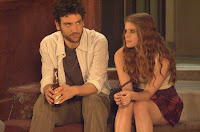Michael R. Miller has had a dream career in film editing. After graduating from Cornell University and working briefly in commercials, he landed the plum job of assistant editor on Woody Allen’s MANHATTAN. He worked in the same capacity on Mr. Allen’s STARDUST MEMORIES and on Martin Scorcese’s RAGING BULL. Subsequently Mr. Miller became a sound editor on Joel and Ethan Coen’s BLOOD SIMPLE, and went on to collaborate with the Coen brothers as picture editor of RAISING ARIZONA and MILLER’S CROSSING. His many other editing credits include Terry Zwygoff’s GHOST WORLD, Herbert Ross’ BOYS ON THE SIDE, Thomas Carter’s SWING KIDS, Rocky Morton and Annablel Jankel’s D.O.A., Keenan Wayans’ I’M GONNA GIT U, SUCKA, Paul Dinello’s STRANGERS WITH CANDY, Michael Bay’s ARMAGEDDON, Rupert Wainwright’s STIGMATA and Anthony Hopkins’ SLIPSTREAM.
He recently edited Josh Radnor’s HAPPYTHANKYOUMOREPLEASE, winner of the 2010 Sundance Film Festival Audience Award, available on dvd since last month. Recently, Mr. Miller directed a music video, "Sick and Dying," for the extraordinary Amanda Jo Williams. His writing about film and filmmaking has been widely published.
Here, he describes this very detailed, organic method of editing the film:

"Josh Radnor’s happythankyoumoreplease, winner of the 2010 Sundance Audience Award, opens today in New York and Los Angeles, then goes wider on March 11th. Editing the film with Josh was a genuine pleasure, despite budget constraints often (and rightly) associated with independently financed productions. It was also a learning experience.
Of course, one learns while working on any motion picture, as each presents an array of unique circumstances. What I gleaned from cutting happythankyoumoreplease was that digital camera technology, used primarily to lower shooting costs, has aesthetic advantages, too. Before discussing them, though, l should say a word about the economic boon that comes from using gear like the Red Camera, Panavision’s Genesis and the Canon 5D.
Savings accrued from shooting digitally are staggering. Even with the best deals on film stock and lab processing, and hour of film costs around $3000. 60 minutes shot digitally is $25, less than 1% of that! The chief selling point for eschewing celluloid, then, is price.
And there are economic benefits of digital cinematography besides lower footage and lab costs. For instance, filmmakers using the latest cameras can shoot for an hour without reloading. A magazine of 35mm film, on the other hand, is empty after 10 minutes. Thus less time (and, therefore, money) are spent changing camera rolls when shooting electronically. What’s more, running out of film in mid-take -- a frustrating, costly and not infrequent occurrence when shooting analogue -- is unlikely when using digital cameras.
The abilitly to record for an hour before “rolling out” is precisely the financial advantage Josh turned into an aesthetic one while making happythankyoumoreplease. Ironically, this directing breakthrough was first presented to me as a descent into lunacy. Phoning from the film’s New York location, one of our producers exclaimed, with great consternation, “You’re gonna get a 40 minute take in tomorrow’s dailies! For a two minute scene!!”
But there was a method to Josh’s madness. He wasn’t just shooting compulsively. Rather, the director used long takes as a rehearsal process. He refined performances while the camera was rolling. As a veteran Broadway and television actor with an MFA in theatre, of course, Josh knew the value of rehearsing, and had to address the fact that low budget indies like happythankyoumoreplease don’t provide time for it.
He also wanted to restore the cut corner of rehearsals because of what he’d learned during his thoroughgoing study of filmmaking in the run-up to principal photography. In addition to picking the brains of seasoned crew members and grilling How I Met Your Mother director Pamela Freyman, Josh read extensively about cinema. One of the texts that inspired him was Sydney Lumet’s Making Movies, which begins with a memorable chapter on rehearsing for film. Perusing this material convinces the reader (who is somehow left craving fresh rye bread, danish and strong coffee) that the rehearsal period is indispensible.
So Josh Radnor incorporated rehearsing into each take, refining performances while the camera turned. Yet with sound and image being recorded non-stop, unrehearsed moments of brilliance were never lost. The work method was similar to that of jazz producers who, when making a record, roll tape even during warm-ups in order to capture any and all inspired playing.
Undoubtedly, this production strategy changed my editing modus operandi, because the concept of a “take” no longer applied. Working with film, a director and editor might agree that Malin Akerman’s “more please” monologue was best, say, in the third take of her close-up. Shooting with the Red Camera, though, Josh could have 10 or more readings of that monologue (and sections thereof) in the digital entity slated “Take 3.” So the old vocabulary ceased to apply.
Using digital editing technology, I placed “locators” (colored markers) in a visual timeline of the material indicating starts and stops -- takes within takes. Thus I could combine the fifth reading of the first part of a line in “take 6” with the third reading of the second part from “take 4” easily, mouse-clicking on well-labelled dots to move those sections into an assembly of the movie. (Both Avid and Final Cut Pro have locacator “tools.”)
In addition to facilitating construction of happythankyoumoreplease, this work method lightened the mood in our editing room: my speed-typing was so bad, it often gave Josh something to laugh about. Locators guiding us to “Close-Ips of Ammie” or “Folly Shots of Nississippi” kept the director amused -- always a good thing during the intense process of cutting a film."
- Michael
Original article HERE.
No comments:
Post a Comment